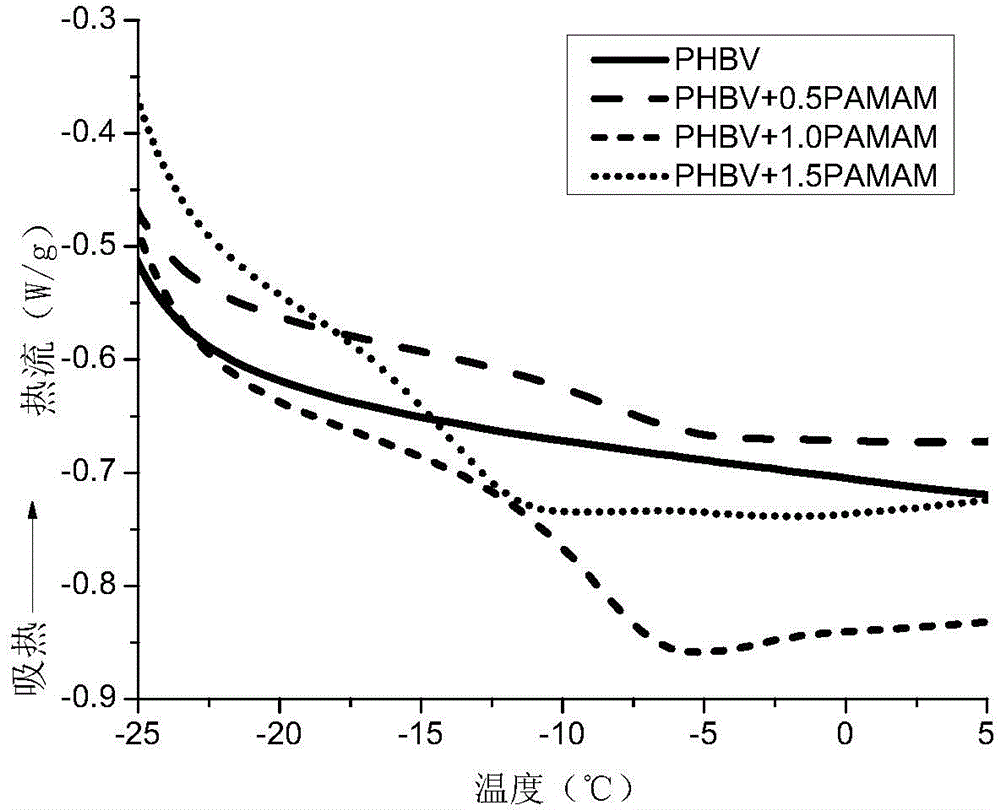PHBV (poly(3-hydroxybutyrate-co-3-hydroxyvalerate)) composite material as well as preparation method and applications thereof
A composite material and reaction solvent technology, applied in the field of composite materials, can solve the problems of easy decomposition, instability, poor mechanical properties and solvent resistance, and achieve the effect of reducing melting temperature and improving toughness
- Summary
- Abstract
- Description
- Claims
- Application Information
AI Technical Summary
Problems solved by technology
Method used
Image
Examples
Embodiment 1
[0032] 1. Synthesis of sixth-generation polyamide-amine (G6.0-PAMAM) dendrimers:
[0033] (1) Take 68.8g of methyl acrylate after vacuum distillation in a 250mL round bottom flask, add 100mL of methanol to dissolve; add 6g of ethylenediamine dropwise at a rate of 2 drops / second, and react at 35°C for 6h; then At 50°C, excess methyl acrylate and reaction solvent methanol were removed under 0.1mmHg vacuum to obtain G0.5-COOCH 3 Polyamidoamine dendrimers.
[0034] (2) Take 240g of ethylenediamine in a 500mL round bottom flask, add 100mL of methanol to dissolve it, and set aside; take G0.5-COOCH 3 20.2g of polyamide-amine dendrimer was dissolved by adding 150mL of methanol, and the obtained solution was added dropwise at a rate of 2 drops / second to the previously obtained ethylenediamine methanol solution, and reacted at 50°C for 24h; then At 65° C., excess ethylenediamine and reaction solvent methanol were removed under 0.1 mmHg vacuum to obtain G1.0NH2 polyamidoamine dendrimer...
Embodiment 2
[0056] 1. Synthesis of the fifth generation polyamidoamine (G5.0PAMAM) dendrimers:
[0057] (1) Take 72.2g of methyl acrylate after vacuum distillation in a 250mL round bottom flask, add 110mL of methanol to dissolve; add 6g of ethylenediamine dropwise at a rate of 2 drops / second, and react at 38°C for 6.8h; Then at 52°C, excess methyl acrylate and reaction solvent methanol were removed under 0.12mmHg vacuum to obtain G0.5-COOCH 3 Polyamidoamine dendrimers.
[0058] (2) Take 250g of ethylenediamine in a 500mL round bottom flask, add 120mL of methanol to dissolve it, and set aside; take G0.5-COOCH 3 22.6g of polyamide-amine dendrimer was dissolved by adding 160mL of methanol, and the obtained solution was added dropwise at a rate of 2 drops / second to the previously obtained ethylenediamine methanol solution, and reacted at 53°C for 26h; then At 65°C, remove excess ethylenediamine and reaction solvent methanol under 0.08mmHg vacuum to obtain G1.0-NH 2 Polyamidoamine dendrimer...
Embodiment 3
[0072] 1. Synthesis of sixth-generation polyamide-amine (G6.0PAMAM) dendrimers:
[0073] (1) Take 56.3g of methyl acrylate after vacuum distillation in a 250mL round bottom flask, add 120mL of methanol to dissolve; add 5.6g of ethylenediamine dropwise at a rate of 2 drops / second, and react at 32°C for 6.8h ; Then at 48°C, excess methyl acrylate and reaction solvent methanol were removed under 0.13mmHg vacuum to obtain G0.5-COOCH 3 Polyamidoamine dendrimers.
[0074] (2) Take 220g of ethylenediamine in a 500mL round-bottomed flask, add 90mL of methanol to dissolve, and set aside; take 18.8g of G0.5-COOCH3 polyamide-amine dendrimer, add 140mL of methanol to dissolve, and the obtained solution Add dropwise at a speed of 2 drops / second to the previously obtained ethylenediamine methanol solution, and react at 48°C for 24 hours; then remove excess ethylenediamine and reaction solvent methanol at 62°C under 0.14mmHg vacuum, Get G1.0-NH 2 Polyamidoamine dendrimers.
[0075] (3) T...
PUM
| Property | Measurement | Unit |
|---|---|---|
| melting point | aaaaa | aaaaa |
Abstract
Description
Claims
Application Information
 Login to View More
Login to View More - R&D
- Intellectual Property
- Life Sciences
- Materials
- Tech Scout
- Unparalleled Data Quality
- Higher Quality Content
- 60% Fewer Hallucinations
Browse by: Latest US Patents, China's latest patents, Technical Efficacy Thesaurus, Application Domain, Technology Topic, Popular Technical Reports.
© 2025 PatSnap. All rights reserved.Legal|Privacy policy|Modern Slavery Act Transparency Statement|Sitemap|About US| Contact US: help@patsnap.com



